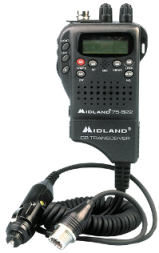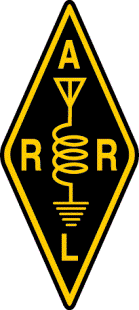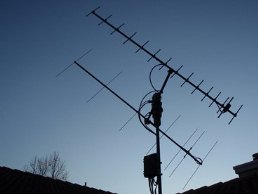Disaster & Communications
During a disaster, circumstances may require emergency communications. Whether trying to send a distress signal or only learn the latest information regarding current events. Information is knowledge, and having the ability to give or receive it could be the difference in surviving a crisis situation. Because reliable communications during a crisis may be affected by damage to infrastructure systems. The ability to manage communication, either utilizing or independent of existing infrastructure, should be a goal for anyone preparing for a survival/disaster event. In order to communicate effectively, it's necessary to know the different modes of communication available.
For this topic, divices like conventional telephones or intercoms are excluded. Because of their excellent engineering, basic phone service can often stays operational days after the power fails. While service may continue during a disaster, communications may be difficult due to overloading of the system. Cellular phone and paging systems will also be excluded. A power outage for an extended period could result in shutdown in the cell they depend on to function. Also, as in conventional phone systems, cellular networks may also be subject to heavy use during a crisis and potentially become ineffective.
Broadcast Communications:
AM Radio
Certain AM broadcast stations in the United States are designated as clear-channel stations. These stations have been assigned the highest protection from interference from other stations, particularly concerning night-time skywave propagation. Because of the protection these stations are granted, they must operate with a nominal power of 50 kilowatts or more. Allowing them to broadcast up to a 750-mile radius around thier transmitter. This concept allow listeners in disaster areas to recieve broadcast information from areas not affected by the event. Disaster agencies also have the capability to provide portable radio stations that broadcast on the AM band. AM program formats consist mainly of talk radio and news programming, well suited for gathering information. The combination of clear-channel stations and mobile field stations, among other factors, make the AM band a prime broadcast frequency to be monitored during times of emergency.
AM radio broadcast can be severely disrupted in large urban centres by metal structures, tall buildings, electrical motors, and fluorescent lights. It is also susceptible to atmospheric interference.
NOAA Weather Radio
NOAA Weather Radio is a network of radio stations broadcasting continuous weather information. It is operated by the National Weather Service (NWS), an agency of the National Oceanic and Atmospheric Administration (NOAA). NOAA Weather Radio broadcasts National Weather Service warnings, watches, forecasts and other hazard information 24 hours a day. It also broadcasts alerts of non-weather emergencies such as national security, natural, environmental, and public safety through the Federal Communications Commission's Emergency Alert System.
NOAA Weather Nationwide Frequencies (MHz)
|
162.400
|
162.425
|
162.450
|
162.475
|
162.500
|
162.525
|
162.550
|
Two-Way Communications:
Family Radio Service
Family Radio Service (FRS) operate on 14 channels around the 462 Mhz and the 467 Mhz frequencies, with no license requirements. Depending on terrain tests show ranges of as much as 2 miles. FRS radios utilize a system known as Continuous Tone Coded Squelch System which gives additional control of interference. FRS stations on channels 1 through 7 may communicate with GMRS stations on those shared channels.
General Mobile Radio Service
General Mobile Radio Service (GMRS) is designed for short-distance two-way communication. A license is required. GMRS share the FRS frequency band near 462 and 467 MHz. Reliable range is considered to be line-of-sight and the distance to the radio horizon can be estimated based on antenna height. Theoretical range between two hand-held units would be about one or two miles, mobile units have higher antennas and range of around 5 miles.
Multi Use Radio Service
Multi Use Radio Service (MURS) is VHF CB. No license required. There are 5 MURS channels a few hertz above the 144 ham band. MURS is not a heavily used band. So if you are looking to be able to use the radios with minimal interference, that is a benefit. It also means that if you are trying to reach out to someone for help, there will be less of a chance of anyone being able to respond to you.
Amateur Radio
FEMA has sponsored a new branch of the amateur service called Radio Amateur Civil Emergency Service (RACES). RACES operators are authorized to operate if the President invokes his War Emergency Powers while all other amateur operation would be silenced. The combination of local/long distance capabilities and the ability to operate independent of existing infrastructure, are a few examples that make the ham bands prime frequencies to monitor during times of emergency. Amatuer Radio has basically 4 bands.
Additional Options:
There are many other options for communication during emergencies. Although for different reanson, may not be as suitable as those listed above. A couple are:
1750 Meter Band
The 1750-meter band allows radios to operate at frequencies in the 170 Khz range, with no license requirements. Communication is not reliable at long ranges; however, at night when the noise level is low 1750 meters can range as far as a few miles. A special high-survivability data network known as the ground-wave emergency network, or GWEN, can be heard between 150 and 170 Khz. This network is intended to survive a massive nuclear strike and provide low-data-rate post apocalyptic communications.
49 Mhz Radios
The 49 Mhz band is a widely-used consumer radio band, primarily for cordless phones, with no license requirements. Depending on terrain tests show ranges of .125 to .5 mile. They perform very well in hilly terrain at short range. The 49 Mhz band is in the middle of the VHF-low band (30-88 Mhz) that the military uses for tactical communications. The military also has the capability to easily intercept, locate via direction-finding, and jam these frequencies.
Marine Radio
The 156-160 MHz marine band is intended for use on the water only. Citizens on board boats under a certain length and weight are allowed to use mobile marine radio without a license. Maximum ranges of up to about 60 nautical miles between aerials mounted on tall ships and hills, and 5 nautical miles between aerials mounted on small boats at sea level are typical.
Communication Modes:
Modes are basically the way a signal is modified to carry information. The most common modes are:
- AM - This is the mode that standard CB uses, and some ham activity. This mode uses more energy for a given amount of output power. If you want to conserve power, and get distance, this is not the mode to use.
- FM - This mode is most common on the FRS, GMRS, handheld and mobile radios for ham use. Again it uses more power, and will not get a signal as far, but when you do get a signal, it will tend to be very clear.
- SSB - Is a method of AM where the carrier wave and one of the side bands (upper or lower) is suppressed. This is what most form of HF communications utilizes for voice, as well as some CB's that have the capability.
- CW - Short for continuous wave or morse code. A method of communication with a small bandwidth, and useful when communications conditions are poor, and can go for a very long distance.
- Digital - In general these are text based modes that use some sort of computer interface to a radio. They include radio teletype, packet modes and many others.
Communication Equipment:
Todays modern technology has made it possible for features that were once only availiable in large base stations to be included in mobile radios. The size of all radios have been reduced while improving both durability and performance. All these advancements have been implemented while reducing cost.
Broadcast
Shortwave Radios
These radios can receive radio transmission on frequencies between 3 and 30 MHz. The main characteristic of these frequencies is their ability to "propagate" for long distances, making possible such world-wide communications as international broadcasting. You can hear news and other programs from a wide range of sources, and you can get emergency information by listening to amateur radio broadcasts including Single Side Band transmissions. You also have Longwave band for Ship-to-Shore calls. FM and AM are also possible.
Scanners
A scanner is a radio receiver that can automatically tune, or scan, two or more discrete frequencies, stopping when it finds a signal on one of them and then continuing to scan other frequencies when the initial transmission ceases. The terms radio scanner generally refer to a communications receiver that is primarily intended for monitoring VHF and UHF landmobile radio systems, as opposed to, say, a receiver used to monitor international shortwave transmissions. These scanners can also tune to different types of modulation as well (AM, FM, WFM, etc.). Modern microprocessors have enabled scanners to store thousands of channels and monitor hundreds of channels per second. Recent models can follow trunked radio systems and decode APCO-P25 digital transmissions.
Two-Way
Mobile Radios
These radios are larger than portable radios and are designed to be mounted in a fixed location inside a vehicle. Like the portable radios, mobile radios contain both a transmitter and a receiver and may contain an internal speaker. However, mobile radios connect to the vehicle's power supply, which enables them to have a higher transmitter output power (typically 5 W to 50 W) and an external antenna. The microphone is usually handheld, and the speaker may be externally located to the radio. Because of the higher transmitter power and external antenna, the effective communication range is greater than that of a portable radio, especially if a repeater is not used. The receivers in mobile radios are generally more sensitive than the receivers found in portable radios. As with portable radios, mobile radios may be combined into a radio communication system with other portable, mobile, and base station radios.
Base Station Radios
A base station radio also contains a transmitter and a receiver. The radio is powered by an external electrical system (typically 110 V ac) and is connected to an antenna located tens to hundreds of feet away, typically on top of a building or on a tower. Because the base station radio uses an external electrical system compared with portable and mobile radios, they have the most powerful transmitters (5 W to hundreds of watts) and the most sensitive receivers. They usually have more features, better filtering (audio and signal), but are large and require a substantial amount of power to run. Microphones can either be handheld or desktop models, and the speaker can either be external or internal to the radio.
Repeaters
A repeater is a specialized radio that contains both a receiver and a transmitter. Repeaters are used to increase the effective communications coverage area for portable, mobile, or base station radios that otherwise might not be able to communicate with one another. The repeater's receiver is tuned to the frequency used by a portable, mobile, or base station transmitter for incoming signals, and the repeater's transmitter is tuned to the frequency used by a portable, mobile, or base station receiver. The incoming signal is rebroadcast back to the radio network on a different frequency, usually with more power and from a higher location.
Amplifiers
Many times, when a transmitter has converted the sound into radio waves, the results are too weak to be properly broadcast. An amplifier takes the signal and, gives its sound more power, makes it stronger so that it can be broadcast to listeners. Amplifiers come in many power levels and generally correspond to particular transmitters and antennas. A linear amplifier can significantly increase the operating distance of a radio.
Antenna
The antenna is the most important part of the system. There are many variations of antennas but the main three configurations are: vertical, dipole, and beam.
- Vertical - These antennas are what people are most familiar with. Car radio antennas, CB antennas, your handheld radio. They can be very tall, or short, depending on the frequency range. Easy to deploy, but cumbersome due to materials. Generally good antennas for use in the VHF and UHF bands, but quite large for HF work.
- Dipole - These are usually made of wire, and strung between to vertical points (trees, houses, etc.). Easy to make, can be concealed, lightweight if needed, and normally used on HF, but could be used on VHF and above. For portability these are an excellent choice on HF and 6 meters.
- Beam - These are usually made out of tubing, and put on top of a tower. They provide gain, and can be used on all bands, but the lower HF portion can be quite large and use tricks to electrically make them larger. For VHF use, they can be quite small and portable.
Antenna Tuners
These are devices that allow antennas that are not designed for a specified frequency to operate on that frequency. There are automatic and manual, they work by matching the impedance of the antenna and feedline to the transceiver.




